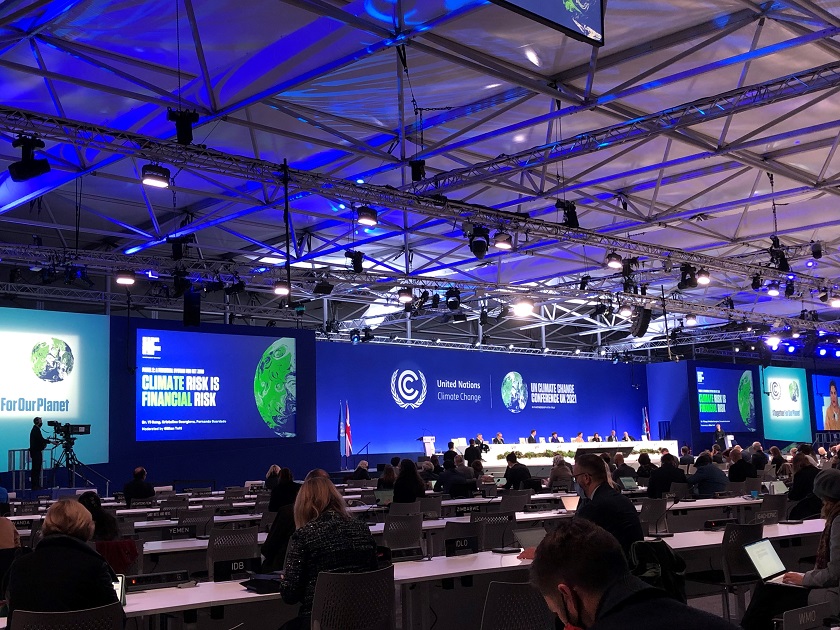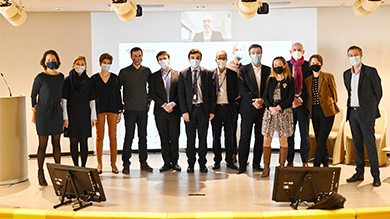After two weeks of intense diplomatic negotiations, the 26th climate summit of the United Nations finally came to an end on Saturday night with the release of the Glasgow climate pact. Facing the urgency of the climate crisis, COP26 had been presented by its organisers as the last best chance to combat global warming. More than 120 heads of states had made the trip to Scotland, alongside tens of thousands of negotiators, government delegates, businesses, civil society representatives and citizens.
Amongst them, Karen Degouve, head of sustainable business development, attended the summit as a business observer, representing Natixis. Karen has been involved in climate finance for over 15 years and participated in several COPs in the past. We have asked her to explain what the expectations of COP26 were, its outcome, and the role of private finance in addressing the global climate crisis.
The UN has been bringing together almost every country on earth for global climate summits every year for nearly three decades, why was COP26 of particular importance?
Over that period of time, climate change has gone from being a sideline issue to a global priority. The world has already warmed 1.1°C above preindustrial levels. With the devastating effects of climate change being experienced around the world as storms, floods, droughts, and wildfires intensifying, there is clearly now a feeling of extreme urgency. But we are not acting fast enough. At the start of the two-week summit, world leaders, including UK Prime Minister Boris Johnson and US President Biden, framed the meeting as the world’s “last best chance” to save the planet from disaster. Leaders from the world’s poorest and most climate vulnerable countries stressed it is a matter of survival for their populations. Time for action is running out.
“For us, this is a matter of survival. We put our homes on the line, while those who have other options decide how quickly they want to act to save those who don't.” - Aminath Shauna, Minister of Environment, Climate Change and Technology of the Maldives
But wasn’t that already the case at COP21 in 2015?
In Paris six years ago, countries struck an agreement to work together to limit global warming to well below 2°C while pursuing efforts to limit rises to 1.5°C (mitigation), to adapt to the impacts of climate change (adaptation) and to make money available to deliver on these aims (finance). Since then, scientists of the IPCC have warned 1.5°C is the threshold beyond which every fraction of a degree of warming will result in calamities like deadly heat waves, water shortages and ecosystem collapse. The target must be to limit the average temperature rise to 1.5°C and no more. Under the Paris Agreement, countries committed to bring forward their national plans which set out how much they would reduce their emissions - known as Nationally Determined Contributions (NDCs), and to come back every five years with an updated plan that would reflect their highest possible ambition at that time. But the NDCs laid out in Paris did not come close to limiting global warming to 1.5°C. So, with a one-year delay due to the pandemic, countries were expected to join COP26 with more ambitious emissions cuts to “keep 1.5°C alive” (quoting the COP26’s president Alok Sharma).
What else did the UK presidency expect to achieve at COP26 in Glasgow?
Before the summit, the UK presidency had been very clear on the 4 targets it was expecting to achieve in Glasgow:
- Mitigation: secure global net zero by mid-century and keep 1.5°C within reach. Countries were asked to come forward with ambitious 2030 emissions reduction targets, including an acceleration of the phase-out of coal, the development of renewable energy, the curtailing of deforestation and switching to electric vehicles.
- Adaptation: enable countries affected by climate change to adapt to protect communities and natural habitats.
- Mobilize finance: unleash the trillions of private and public sector finances required to realize the first two goals and secure net zero. More than 10 years ago (at COP15 in Copenhagen in 2009), developed countries promised to mobilize $100bn annually by 2020 to help developing countries mitigate and adapt to climate change. That promise has not yet been fulfilled: by 2019, the latest year for which data is available, only $80bn flowed. COP26 aimed at fulfilling this past commitment and increasing the annual amount to finance the adaptation of the most vulnerable countries.
- Implementation of the Paris Agreement: finalize the rules to operationalize the Paris Agreement - the so-called Paris Rulebook, to turn climate ambition into real action through increased collaboration between governments, businesses, and civil society. UN High Level Champions on Climate Action were nominated in various sectors for that purpose.
After two weeks of negotiations, COP26 finally came to an end on Saturday night with the release of the Glasgow climate pact. Does it meet these expectations? What are the key points of the text agreed by nearly 200 countries?
The COP26 president called the agreement struck a “fragile win” for climate. Some progress was made in Glasgow, but clearly not all the expectations were met. The agreement establishes a clear consensus that all nations need to do much more, immediately, to prevent a catastrophic rise in global temperatures. It outlines specific steps the world should take, from slashing CO2 emissions nearly by half by 2030 to curbing methane, and it sets up new rules to hold countries accountable for the progress they make or fail to make. It calls on governments to return next year with stronger plans to curb their emissions and urges wealthy nations to “at least double” funding by 2025 to protect the most vulnerable nations from climate hazards. But it leaves the crucial question of how much and how quickly each country should cut its emissions over the next decade unresolved.
Here are the key points of the text agreed by negotiators:
1) Keeping 1.5°C alive: Some countries came to Glasgow opposed to stronger action and tried to suggest that focusing on 1.5°C was reopening the Paris Agreement. The COP26 UK presidency and supporters such as special US envoy John Kerry repeatedly pointed out that “well below” 2°C could not mean 1.9°C or 1.8°C. There are repeated references in the text to “the best available science”, which has moved on since the Paris Agreement. We can say the argument at Glasgow was firmly won in favor of 1.5°C, an achievement for the UK presidency and much better for the planet.
2) Emissions cuts: A majority of countries had improved their NDC targets compared with two years ago ahead of COP26, including major emitters such as Europe, the US and China, but their emissions-cutting pledges remain insufficient to hold global warming to 1.5°C. Two major emitters produced new NDCs during the summit, also joining the growing chorus of nations pledging to reach net zero emissions: India set a target to reduce its emissions by 1bn tons of CO2 equivalent by 2030 and reach net zero with a very late 2070 deadline, and Brazil reinforced it target from a 43% to a 50% emissions cut by 2030 and reaching net zero in 2050. Other countries, including Australia, Saudi Arabia and Russia, remain so far off course that they are pushing the planet towards 4°C above pre-industrial levels. According to Climate Action Tracker, full implementation of current 2030 NDCs targets would lead to a 2.4°C of temperature rise, dangerously outside the 1.5°C objective, yet this is a progress to be compared with the previous 3.2°C global outlook. Under the Glasgow climate pact, nations are also asked to return one year from now to strengthen their pledges, instead of waiting five years, as was set in the 2015 Paris agreement. So revised NDCs will be on the agenda for next year’s COP to be held in Egypt. Setting a roadmap for revisions next year, rather than several years away, is a good move.
3) Phase-down of unabated coal and inefficient fossil fuel subsidies: Coal is by far the dirtiest and most carbon-intensive fossil fuel. The International Energy Agency has made clear that if it is not rapidly phased out, the world has no hope of staying within 1.5°C. To hit the target, no new coal-fired power plants can be built and at least 40% of the world’s 8,500 existing ones must be closed by 2030. It may seem incredible, given how central fossil fuels are to the climate crisis, but since the Kyoto Protocol was signed in 1997, no COP decision had ever made a direct reference to phasing out fossil fuels. This reflects fierce opposition from oil-producing and coal-producing countries, and from those heavily dependent on consuming fossil fuels. The Glasgow climate pact, for the first time ever in a final COP decision statement, contains language directing all nations to increase efforts to “phase down” unabated coal and inefficient fossil fuel subsidies, though it gives no firm deadlines. Originally that was a “phase out”, but India insisted on the change in the last hours of the negotiation, despite pleas from other developing countries. Even with the watered-down wording and the dubious carbon capture loophole, this should be considered as a major step forward.
4) Financing of adaptation: Developing countries have been promised that increased financing from rich countries, from public and private sources, will amount $500bn for the next five years. They were also calling for more financing to be spent on adaptation. This is important because most of the climate finance currently available goes to funding emissions-cutting projects, such as profitable renewable energy projects in middle income countries that could often be funded easily without help. But the poorest countries who need money to adapt to the impact of extreme weather struggle to obtain any funding at all. In the end, the text agreed to double the proportion of climate finance going to adaptation from 2019 levels to 2025. Some countries were calling for a 50:50 split between funding for emissions cuts and funding for adaptation, so this has fallen short but is still a significant step.
5) Loss and damage: Loss and damage refers to the ravages of the climate crisis that are too destructive for countries to prevent or adapt to them. The subject has been discussed for a decade without progressing much, with developing countries calling for compensation from liable developed countries. At the previous COP, discussions moved on far enough for the setting up of a database and reporting system called the Santiago Network. Many developing countries were hoping that COP26 could provide a further step towards some form of funding mechanism for loss and damage. That has not happened, although loss and damage was for the first time mentioned in the cover section of the Glasgow climate pact, and the issue will return to the talks next year.
6) Rules for global carbon markets: Negotiators also closed a deal setting rules for carbon markets, potentially unlocking trillions of dollars for protecting forests, building renewable energy facilities and other projects to fight climate change. Companies as well as countries with vast forest cover had pushed for a robust deal on government-led carbon markets in Glasgow, in the hope of also legitimizing the fast-growing global voluntary offset market. Under the agreement, some measures would be implemented to ensure credits are not double-counted under national emissions targets, but bilateral trades between countries would not be taxed to help fund climate adaptation - that had been a core demand for less developed countries. Negotiators also reached a compromise that sets a cut-off date, with credits issued before 2013 not being carried forward. That is intended to ensure too many old credits don’t flood the market and encourage purchases instead of new emissions cuts.
On Saturday night, as the agreement was reached with last-minute changes to its wording on coal, we saw the president of COP26, Alok Sharma, fighting back tears and saying he was “deeply sorry”. Since then, activists around the world have said the agreement is very disappointing. Would you say COP26 is a failure?
No. After two weeks of intense negotiations, I think it would be unfair to call the outcome of COP26 a failure. The UN climate negotiation process is complicated. Multilateralism is complex by nature; it requires close to 200 countries each with their particular economic interests in domestic politics to act in unison for the greater good. Although the speed of work may seem inadequate, which is frustrating at times, I believe some real progress was made in key areas. Of course, we are still far from what needs to be achieved to secure a maximum 1.5°C temperature increase by the end of the century, but the summit has made significant progress on emissions targets, climate finance, deforestation, methane emissions, and most importantly, emissions from fossil fuel burning. I would agree with the optimism of US climate leader John Kerry who said “COP26 puts us closer than ever to avoiding climate chaos”.
Progress is reflected both in the final Glasgow climate pact, but also, and maybe even more importantly, through other international agreements that were reached during the summit:
- On deforestation: leaders of more than 100 countries including Brazil, China, Russia, and the US vowed to end deforestation by 2030. The agreement covers over 85% of the world’s forests, which are essential natural carbon sinks. $19bn are expected to be mobilized under the agreement to protect and restore native forests, $12bn from governments and $7bn pledged by private companies.
- On the support for Indigenous Peoples and Local Communities: two dozen countries and foundations pledged $1.7bn of financing from 2021 to 2025 to help advance forest tenure rights for Indigenous Peoples and Local Communities, and recognize their role as guardians of forests and nature. This new step is important because as much as 65% of global land is community land, supporting over 2 billion people, including up to 500 million indigenous peoples. Yet only 10% of land is recognized under national laws as belonging to Indigenous Peoples and Local Communities. Community land is under growing threat from companies and investors scrambling to acquire acreage for investment purposes and industrial agriculture, and from illegal activities like logging, mining, and hunting.
- On methane emissions: countries representing 46% of global methane emissions (including China) have pledged to cut emissions by 30% by 2030 from 2020 levels. It is the first time ever such a pledge has been made concerning methane, which has a heating power 20-times higher than CO2 and is responsible for approximately 20% of global warming. The pledge was part of a push by the Biden administration, which also announced the US EPA will limit methane coming from one million oil and gas rigs across the US. Unfortunately, the pledge does not include some large methane emitters such as Russia and Iran.
- With the US and China joint agreement: the world’s two biggest polluters announced a joint agreement to do more to cut emissions this decade. Although the agreement was short on specifics, China did agree to phase-down coal starting in 2026.
- On the phasing out of coal power: 23 countries made new commitments to phase out coal power, including five of the world’s top 20 coal power-using countries (South Korea, Indonesia, Vietnam, Poland, Ukraine), although China is not part of this agreement. In a new Global Coal to Clean Power Transition Statement, countries also committed to scaling up clean power and ensuring a just transition away from coal.
- With the commitment to end international public financing of unabated coal in 2021: China, Japan, South Korea, and major international banks committed to effectively end all international public financing of new unabated coal power by the end of 2021. This means all significant public international financing for coal power should be effectively ended by the end of the year.
- With the commitment to end international public financing of other unabated fossil fuels in 2022: a group of 39 countries including the US, Canada, Italy, France, Denmark together with public finance institutions signed a UK-led joint statement committing to ending international public support for the unabated fossil fuel energy sector by the end of 2022, and instead prioritize support for the clean energy transition. Collectively, this could shift an estimated $17.8bn a year in public support away from fossil fuels and towards the clean energy transition. This was considered a milestone moment at COP26.
- With the Beyond Oil and Gas Alliance (BOGA): founded by Denmark and Costa Rica, and including France, Ireland, Sweden, Wales, Greenland and Quebec, the alliance has committed to phase-out fossil fuel extraction. While most of the largest oil and gas producers in the world, including the US and Russia, are nowhere to be found in the alliance, some of the signatories are substantial producers or have substantial reserves. When Denmark made the decision in 2019 to begin its phaseout, it was the biggest oil producer in the European Union, and Greenland has huge reserves that it will forgo. This is only a first step, but it is a welcome development.
- With the Just Transition Declaration signed by over 30 nations, including the UK, the US, all 27 EU member states, Norway, Canada and New Zealand. The Declaration recognizes that the effects of climate change and of decarbonizing the economy will fall disproportionately on those in poverty or insecure work, those in carbon-intensive industries, and those in fossil-fuel dependent countries, and that it risks exacerbating gender, racial, age and other inequalities. It aims to ensure that no one is left behind as the world transitions to a climate-friendly economy, particularly those working in sectors, cities and regions reliant on carbon-intensive industries and production. It reflects the International Labour Organization (ILO)’s 2015 Guidelines for a Just Transition, which outline the necessary steps towards well-managed environmentally sustainable economies and societies, decent work for all, social inclusion and the eradication of poverty.
How did the private financial sector contribute to COP26 and the final agreement?
Financial sector representatives can be proud of what was achieved in the run to COP26 and on Finance Day (November 3) which put the industry at the center of a COP agenda for the first time. The message from the stage at the conference was clear: the money is there, the ambition is there, and new common tools and standards are being built.
The key developments and their implications for financial institutions include:
1) The financial sector has mobilized at scale. The financial industry is a critical enabler of efforts to decarbonize the global economy. To meet the challenge, the core of the global financial system must align its activities with net zero. The Glasgow Financial Alliance for Net Zero (GFANZ), led by UN special envoy for climate action and finance Mark Carney, was launched with the aim of raising standards, driving ambition and ensuring the net zero commitments of financial institutions are transparent, credible and consistent, using the criteria and architecture of the UN’s Race to Zero. At COP26, GFANZ announced that more than 450 firms across 45 countries that represent more than $130 trillion of financial assets (over 40% of the global financial system) have committed to aligning their activities with the net zero transition, i.e. have committed to setting concrete, science-based, net zero-aligned targets, and working to deliver the $100 trillion investment needed to achieve net zero over the next three decades. GFANZ also announced that it will continue working beyond COP26 with Michael Bloomberg joining Mark Carney as co-chairs. It will continue to provide industry-wide coordination on turning commitments into action. Groupe BPCE is fully part of that commitment for its banking activities through the Net Zero Banking Alliance (NZBA).
2) A new International Sustainability Standards Board (ISSB) was announced to develop a comprehensive global baseline of sustainability disclosure standards, building further upon the work of the Task Force for Climate-Related Financial Disclosures (TCFD). The Board will sit under the IFRS (International Financial Reporting Standards Foundation) alongside the IASB (International Accounting Standards Board) and be based in Frankfurt, with offices in Montreal, San Francisco, and London. This is a major step toward improving the quality of data on net zero.
3) The UK announced a Net-Zero-aligned Financial Sector. UK financial institutions will be required to publish firm-level transition plans setting out how they will decarbonize in line with the UK government’s net zero commitment on a comply or explain basis. A new taskforce is being set up in the UK government to develop standards for transition plans and associated metrics, coordinating with GFANZ and reporting by the end of 2022. The UK is setting a precedent, other financial centers may follow.
4) The UN Secretary General announced the creation of an expert committee to develop standards for corporate net zero targets to enhance transparency and comparability of commitments.
5) Central banks released the NGFS Glasgow Declaration: signed by 100 central banks committed to advancing supervisory practices, the Network for Greenifying the Financial System (NGFS) announced that it will expand and strengthen its collective efforts to improve the resilience of the financial system to climate-related and environmental risks and encourage the scaling up of the financing flows needed to support the transition towards a sustainable economy. Additionally, the Bank of England announced that it will shift gears to actively supervise firms on climate-related financial risks and recognizes that capital may have a bigger role to play in providing resilience against the consequences of climate change.
6) 33 financial institutions committed to halting the financing of agricultural commodity-driven deforestation: following the landmark non-deforestation pledge signed by over 100 nations, 33 financial institutions with $8.7 trillion in assets under management announced that they will work to phase out deforestation impacts across investee supply chains for palm oil, soy, beef, and pulp and paper by 2025. According to UNEP, the world needs to close a $4.1 trillion financing gap in nature by 2050 to reach net-zero emissions, whereas investments in nature-based solutions currently amount to $133bn, most of which is public money. There is no viable pathway to net zero emissions that does not involve protecting and restoring nature on an unprecedented scale. As nature and biodiversity are becoming the next big focus, financial institutions will need to develop capabilities to measure and monitor their activities’ impact on deforestation and develop approaches to significantly reduce it. The deal follows the recent formation of the Taskforce on Nature-related Financial Disclosures (TNFD), which is working on a risk management and disclosure framework for organizations to report and act on nature-related risks, and to which Natixis is proud to be actively contributing. It is also ahead of the next very important biodiversity COP (COP15) that will take place in Kunming, China in April 2022.
7) Other topics discussed extensively at COP26 concerning the financial sector included fossil fuel financing, with NGOs and activists often at odds with financial institutions on the pace and scale of fossil fuel financing phase-out plans, and the need to scale up financial flows to emerging markets and developing countries, with annual investment needs for clean energy alone expected to be greater than $1 trillion by the end of the decade.
What do you expect the next steps to be?
If we want to beat back the climate crisis, no one can sit on the sidelines: all countries, all corporates, all financial institutions need to get on board. For all actors, it is now time to translate net zero commitments into concrete action. In the financial sector, we must now implement the commitments made under global net zero alliances, including the Net Zero Banking Alliance for banking activities. 92 banks in all regions of the world representing 43% of banking assets worldwide have signed up to NZBA to date, now standing together and firmly committed to achieve net zero. It is a huge success, and the commitment’s timeline means immediate action is required by all signatory banks. I am proud to be co-leading the NZBA implementation work track, to support banks with their practical implementation of the commitment and provide a voice for the banking sector on the topic of net zero and alignment.
For Natixis, this will mean building up on our Green Weighting Factor methodology to monitor the climate impact of our banking activities and deliver on the granular targets we have committed to by sector and geography as part of our 2024 strategic plan. We have put in place an action plan to deliver on those targets, which includes amongst other things a 15% reduction of our financing of the upstream oil and gas sector, and a sharp increase of renewable energy financing (€9bn of new financing over 4 years).
Speaking more generally for financial institutions, net zero will be achieved through:
- increased engagement with our clients to help them reduce emissions at a scale and pace consistent with the 1.5°C target,
- drastically reducing our financing and investment in carbon intensive sectors, fossil fuel energy in particular,
- exploring ways to unlock lending and investments in net-zero technologies: nearly half of the emissions reductions required to achieve net-zero by 2050 will be attributed to the adoption and to-scale deployment of breakthrough decarbonization technologies which today are not yet commercially viable. While global financial institutions have made ambitious pledges to mobilize capital for the net-zero transition, we cannot afford to wait decades to bridge the investment gap.
The decade up to 2030 will be crucial. Our collective task is to deliver the finance, resources, and tools to rapidly deliver climate action. Quoting the UN secretary general, Antonio Guterres, on the last day of COP26, we should be reminded that “The COP26 outcome is a compromise, reflecting the interests, contradictions and state of political will in the world today. It’s an important step, but it’s not enough. It’s time to go into emergency mode. The climate battle is the fight of our lives and that fight must be won!"

















